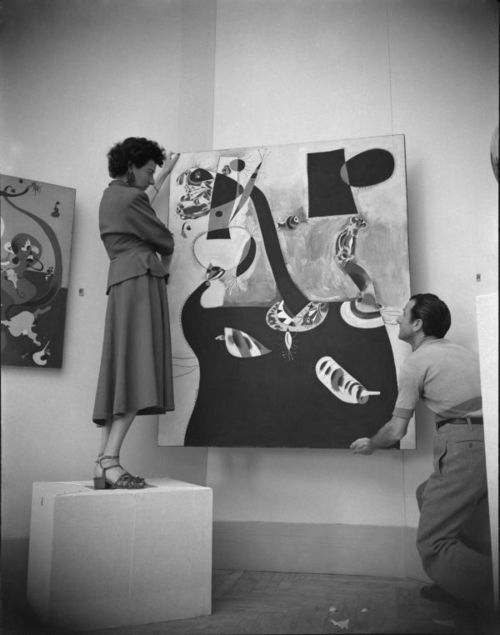Mostra 1948: la Biennale di Peggy Guggenheim a Venezia. Le informazioni sulla mostra 1948: la Biennale di Peggy Guggenheim, i curatori, gli orari di ingresso, il costo dei biglietti, i numeri per prenotare, il comunicato stampa sulla mostra 1948: la Biennale di Peggy Guggenheim del museo Collezione Peggy Guggenheim di Venezia.
Mappa
- Città: Venezia
- Provincia: Venezia
- Indirizzo: Dorsoduro 701
- Telefono: +39 041 2405411
- E-Mail info
- Sito ufficiale
Scheda Mostra
1948: la Biennale di Peggy Guggenheim
Peggy Guggenheim
- Luogo: Collezione Peggy Guggenheim
- Curatori: Gražina Subelytė
- Città: Venezia
- Provincia: Venezia
- Data inizio: 25 May 2018
- Data fine: 14 January 2019
- Costo del biglietto: Intero 15 € | Ridotto 13 € | Ridotto speciale 9 € | Gratuito: Bambini fino a 10 anni, soci
- Telefono per informazioni: +39 041 2405411
- E-Mail info
- Sito ufficiale
Comunicato Stampa:
Il 2018 segna il 70° anniversario dell’esposizione della collezione di Peggy Guggenheim all’interno delle sale del Padiglione Greco alla XXIV Biennale di Venezia.
La prima volta in assoluto che la collezione della mecenate veniva esposta in Europa. Nelle Project Rooms del museo viene ricreato l’ambiente del Padiglione, allestito in quell’occasione dal celebre architetto veneziano Carlo Scarpa.
“La Biennale del 1948 fu come stappare una bottiglia di Champagne. Un’esplosione d’arte moderna dopo il tentativo del Nazismo di ucciderla. Per la prima volta alla Biennale si videro Mondrian, Brancusi, Kandinsky, Ernst e Giacometti, tutti nella collezione di Peggy esposta al Padiglione greco”.
Vittorio Carrain, segretario della Collezione Peggy Guggenheim dal 1948 al 1952
Peggy Guggenheim and her friends
A seguito del grande successo riscosso dalla mostra e in previsione di un 2019 che vedrà Peggy Guggenheim protagonista di un ricco programma espositivo e di lunga serie di attività che ripercorreranno i settant’anni dal suo trasferimento a Palazzo Venier dei Leoni e dalla prima mostra qui organizzata di scultura contemporanea, oltre a ricordarei 40 anni della sua scomparsa, è stata prorogata fino al 14 gennaio 2019 1948: la Biennale di Peggy Guggenheim, a cura di Gražina Subelytė, Assistant Curator del museo, allestita nelle Project Rooms. Nell’anno del 70° anniversario dell’esposizione della collezione di Peggy Guggenheim alla XXIV Biennale di Venezia, presso il padiglione greco, il museo ha voluto commemorare questo momento dirompente nella storia dell’arte del XX secolo con una esposizione, raccolta ma molto mirata, che ricrea fedelmente l’ambiente del padiglione. Oltre a fotografie, lettere, documenti, in parte inediti, a sorprendere il visitatore è un fedelissimo modello tridimensionale che per la prima volta ricostruisce minuziosamente gli spazi e l’allestimento originario del ’48, seguito dall’eminente architetto veneziano Carlo Scarpa. In mostra non mancano due opere, successivamente donate da Peggy Guggenheim al Museo d’arte di Tel Aviv: Composizione n. 113 (1939) di Friedrich Vordemberge-Gildewart e Composizione (1936) di Jean Hélion, che dagli anni ’50 non sono mai più state esposte a Venezia.
“La prima volta di Peggy” ha scritto Elle Decor, “1948: apre il padiglione di Peggy Guggenheim” ha invece titolato il Sole 24 ore, mentre su Avvenire leggevamo “Paradigma Peggy. E la Biennale del 1948 riscrisse l’arte del ‘900”, così come ha scritto il seguitissimo mensile inglese di arte contemporanea e moda Another Magazine “Così il Padiglione di Peggy ha cambiato per sempre l’arte del XX secolo”. Un successo dunque non solo di pubblico ma anche di critica. Di fatto la partecipazione della collezionista americana alla Biennale del 1948, la prima dopo la conclusione del secondo conflitto mondiale, fu un evento miliare non solo perché fu la prima esposizione pubblica di una collezione privata di arte moderna in Italia dopo due decenni di regime dittatoriale, ma anche perché fu la prima presentazione della collezione in Europa, dopo la chiusura della galleria newyorkese Art of This Century (1942-’47) e il trasferimento di Peggy a Venezia.
Dopo un periodo di interruzione cominciato nel 1942 a causa della guerra, è proprio nel ‘48 che la Biennale, fondata nel 1895, comincia a ricoprire un ruolo internazionale sulla scena dell’arte moderna e contemporanea: dal 6 giugno al 30 settembre viene presentata un’esposizione di capolavori dell’Impressionismo, proposta dallo storico Roberto Longhi, una retrospettiva delle opere di Picasso, dal 1907 al 1942, e una mostra nel padiglione principale dedicata ad artisti come Otto Dix, Karl Hofer e Max Pechstein che desidera restituire nuova dignità all’arte bollata come “degenerata” negli anni del Nazismo. L’esposizione della collezione di Peggy Guggenheim, invitata a partecipare dall’allora segretario generale della Biennale Rodolfo Pallucchini su consiglio dell’artista Giuseppe Santomaso, è un avvenimento senza precedenti per la manifestazione. Non si era mai vista fino ad allora nel Vecchio continente una raccolta così rappresentativa di “opere dell’arte non-oggettiva”, con il merito di offrire esempi di tutte le scuole artistiche, dal Cubismo, al Futurismo, e continuate poi con il Dadaismo, il Surrealismo e l’Espressionismo astratto. Di fatto, pur annoverando gli italiani Giacomo Balla, Gino Severini, Giorgio de Chirico e Massimo Campigli, la collezione comprendeva soprattutto i nomi più rappresentativi dell’arte astratta e surrealista, quali Jean Arp, Costantin Brancusi, Alexander Calder, Max Ernst, Alberto Giacometti, Kazimir Malevich, Antoine Pevsner, senza dimenticare i molti artisti americani, da William Baziotes a Jackson Pollock, da Mark Rothko a Clyfford Still, mai esposti al di fuori degli Stati Uniti e qui presenti per la prima volta. Esponendo l’arte contemporanea dell’epoca, la collezione di Peggy Guggenheim si allineava perfettamente con le aspirazioni della Biennale di offrire una visione il più ampia possibile sullo scenario artistico post-bellico. Negli spazi del padiglione concesso dalla Grecia, allora devastata dalla guerra civile, Peggy espose centotrentasei opere, una ventina delle quali saranno in seguito donate a vari musei nel mondo, tra cui il Museo d’arte di Tel Aviv, la Galleria Nazionale d’Arte Moderna di Roma, il Museum of Modern Art di San Francisco, il Museum of Art, Rhode Island School of Design,il Museum of Art dell’Università dell’Iowa e l’Art Museum di Seattle.
Un ringraziamento speciale per la realizzazione della mostra va a Peter Lawson-Johnston, Presidente Emerito della Collezione Peggy Guggenheim, per il supporto alla mostra. Il programma espositivo della Collezione Peggy Guggenheim è sostenuto dagli Institutional Patrons – EFG e Lavazza, da Guggenheim Intrapresæ e dal Comitato Consultivo del museo. I progetti educativi sono realizzati con il sostegno della Fondazione Araldi Guinetti, Vaduz.








